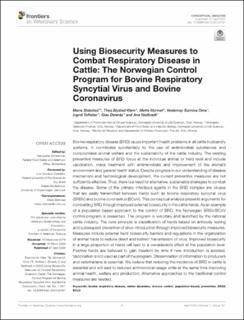| dc.contributor.author | Stokstad, Maria | |
| dc.contributor.author | Klem, Thea B. Blystad | |
| dc.contributor.author | Myrmel, Mette | |
| dc.contributor.author | Oma, Veslemøy Sunniva | |
| dc.contributor.author | Toftaker, Ingrid | |
| dc.contributor.author | Østerås, Olav | |
| dc.contributor.author | Nødtvedt, Ane C. W. | |
| dc.date.accessioned | 2020-11-06T11:00:32Z | |
| dc.date.available | 2020-11-06T11:00:32Z | |
| dc.date.created | 2020-07-23T08:37:45Z | |
| dc.date.issued | 2020 | |
| dc.identifier.citation | Frontiers in Veterinary Science. 2020, 7 . | en_US |
| dc.identifier.issn | 2297-1769 | |
| dc.identifier.uri | https://hdl.handle.net/11250/2686721 | |
| dc.description.abstract | Bovine respiratory disease (BRD) cause important health problems in all cattle husbandry systems. It contributes substantially to the use of antimicrobial substances and compromises animal welfare and the sustainability of the cattle industry. The existing preventive measures of BRD focus at the individual animal or herd level and include vaccination, mass treatment with antimicrobials and improvement of the animal’s environment and general health status. Despite progress in our understanding of disease mechanism and technological development, the current preventive measures are not sufficiently effective. Thus, there is a need for alternative, sustainable strategies to combat the disease. Some of the primary infectious agents in the BRD complex are viruses that are easily transmitted between herds such as bovine respiratory syncytial virus (BRSV) and bovine coronavirus (BCoV). This conceptual analysis presents arguments for combatting BRD through improved external biosecurity in the cattle herds. As an example of a population-based approach to the control of BRD, the Norwegian BRSV/BcoV control-program is presented. The program is voluntary and launched by the national cattle industry. The core principle is classification of herds based on antibody testing and subsequent prevention of virus-introduction through improved biosecurity measures. Measures include external herd biosecurity barriers and regulations in the organization of animal trade to reduce direct and indirect transmission of virus. Improved biosecurity in a large proportion of herds will lead to a considerable effect at the population level. Positive herds are believed to gain freedom by time if new introduction is avoided. Vaccination is not used as part of the program. Dissemination of information to producers and veterinarians is essential. We believe that reducing the incidence of BRD in cattle is essential and will lead to reduced antimicrobial usage while at the same time improving animal health, welfare and production. Alternative approaches to the traditional control measures are needed. | en_US |
| dc.language.iso | eng | en_US |
| dc.rights | Attribution-NonCommercial-NoDerivatives 4.0 Internasjonal | * |
| dc.rights.uri | http://creativecommons.org/licenses/by-nc-nd/4.0/deed.no | * |
| dc.title | Using Biosecurity Measures to Combat Respiratory Disease in Cattle: The Norwegian Control Program for Bovine Respiratory Syncytial Virus and Bovine Coronavirus | en_US |
| dc.type | Peer reviewed | en_US |
| dc.type | Journal article | en_US |
| dc.description.version | publishedVersion | en_US |
| dc.source.pagenumber | 0 | en_US |
| dc.source.volume | 7 | en_US |
| dc.source.journal | Frontiers in Veterinary Science | en_US |
| dc.identifier.doi | 10.3389/fvets.2020.00167 | |
| dc.identifier.cristin | 1820239 | |
| cristin.ispublished | true | |
| cristin.fulltext | original | |
| cristin.qualitycode | 1 | |

